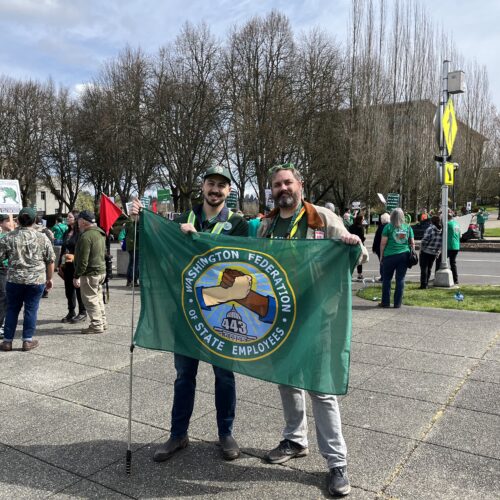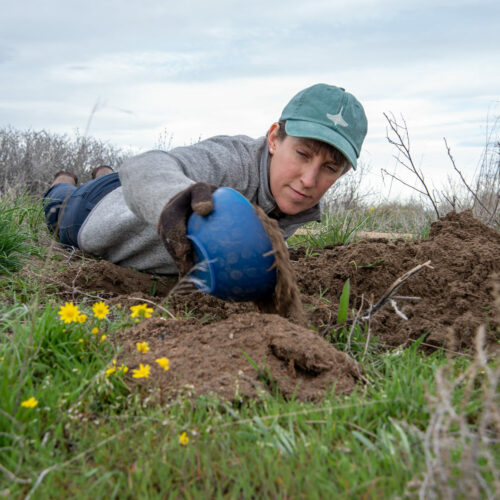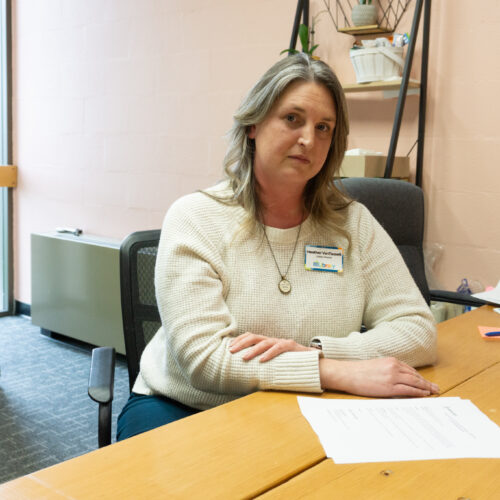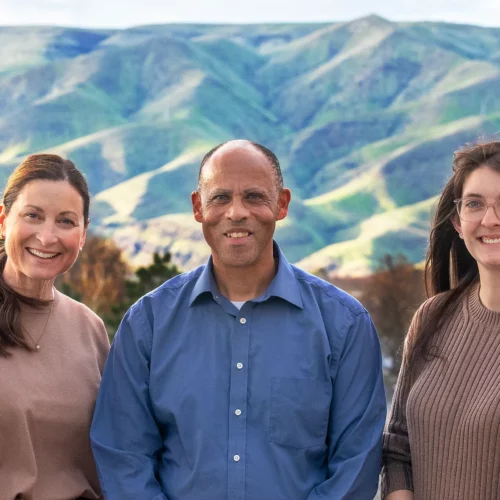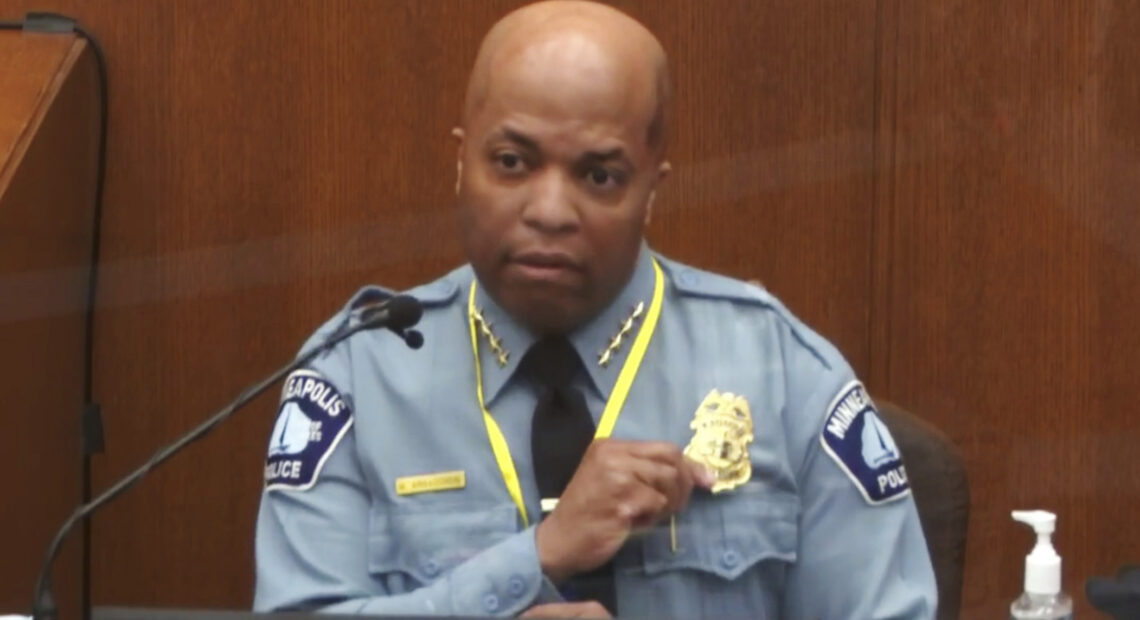
Police Chief Says Derek Chauvin Violated Minneapolis Policies On Use Of Force
BY BILL CHAPPELL & LAUREL WAMSLEY
Minneapolis Police Chief Medaria Arradondo testified for the prosecution Monday in the trial of former officer Derek Chauvin, who is facing murder charges over the killing of George Floyd. The trial is now in its second week of testimony.
Arradondo said that he believes Chauvin’s actions last May 25 violated the police department’s policies on de-escalation, reasonable use of force and rendering aid.
Prosecutor Steve Schleicher showed a still image of Chauvin with his knee on Floyd’s neck as Floyd grimaced in pain, a position Chauvin maintained for nine minutes and 29 seconds.
“There is an initial reasonableness in trying to get him under control in the first few seconds,” Arradondo said, “but once there was no longer any resistance, and clearly when Mr. Floyd was no longer responsive and even motionless, to continue to apply that level of force to a person proned out, handcuffed behind their back – that in no way, shape or form is anything that is by policy, is not part of our training and is certainly not part of our ethics or our values.”
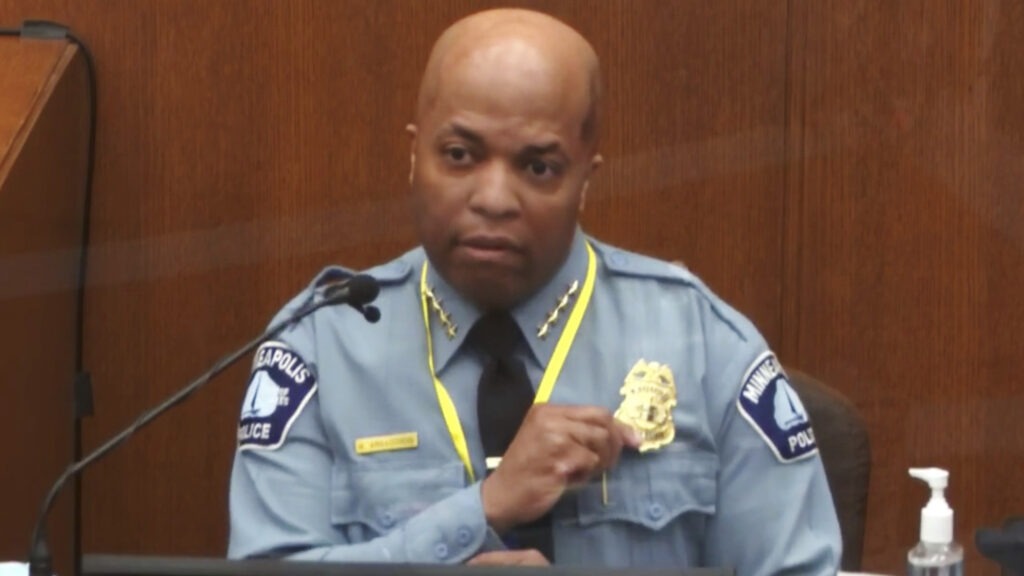
Minneapolis Police Chief Medaria Arradondo testifies Monday in a Hennepin County courtroom during the trial of former officer Derek Chauvin, who faces three criminal charges over the 2020 death of George Floyd.
CREDIT: Court TV/Pool via AP
The chief said that during the restraint officers could not find Floyd’s pulse. But he did not see any of the officers provide medical attention to Floyd, even though he appeared unresponsive.
During cross-examination, defense attorney Eric Nelson showed side-by-side videos of the moment that Chauvin got up off Floyd as paramedics arrived and placed him on a gurney. Arradondo agreed that one officer’s bodycam footage of that moment appeared to show Chauvin’s knee more on Floyd’s shoulder blade than on his neck.
But Arradondo said that a review of the full footage showed Chauvin’s knee on Floyd’s neck up until that time, pinning Floyd in a manner that is not a trained Minneapolis Police Department neck restraint.
Arradondo said that during the video showed by the defense, there was no indication Floyd was aggressive, actively resisting or passively resisting. “Matter of fact, as I saw that video, I didn’t even know if Mr. Floyd was alive at that time,” the police chief said.
“It is my firm belief that the one singular incident we will be judged forever on will be our use of force,” Arradondo told the jury, noting the thousands of calls his department receives every year.
“And so, while it is absolutely imperative that our officers go home at the end of their shift, we want to make sure and ensure that our community members go home, too,” he said.
The sanctity of life is the pillar of the department’s use-of-force policy, Arradondo said – and he acknowledged it wasn’t always the case. The policy was changed in 2016, he said.
Reading aloud from the police manual’s policy on the use of force, Arradondo said: “Sanctity of life and the protection of the public shall be the cornerstone of the MPD’s use-of-force policy.”
Chauvin’s use of force with Floyd violated such policies, Arradondo said: “That action is not de-escalation. And when we talk about the framework of sanctity of life and we talk about the principles and values that we have, that action goes contrary to what we’re taught.”
Sitting in the witness box, Arradondo, 54, described his long career with the Minneapolis police force, including his training in the department’s first police academy class.
The chief testified for more than an hour before the court went into recess for lunch. In the afternoon portion of the session, Schleicher asked the chief about police policies regarding an emotionally disturbed person, referred to by police as an EDP. In 2019, the department dealt with around 4,500 EDP calls, Arradondo said.
Questions also touched on crisis intervention, a police policy similar to its de-escalation measures.
“We want to meet people where they are,” the chief said, later adding, “We recognize that oftentimes, people who are experiencing crisis, it is not something that they brought on themselves but are dealing with.”
Schleicher then turned to the medical training officers receive. Arradondo noted that most officers receive at least some training in first aid, such as “the ABC’s: airway, breathing, circulation,” and know how to use direct pressure to help people who are wounded. And he said officers are expected to use those skills.
“We absolutely have a duty to render that aid,” Arradondo said.
Reading from the police manual, the chief said that officers who are waiting for an ambulance to reach someone in a medical crisis “shall provide any necessary first aid consistent with MPD training, as soon as practical.”
Arradondo spent portions of his career both working in and later commanding the department’s internal affairs unit, he told jurors Monday.
Discussing the department’s motto – “To protect with courage and to serve with compassion” — he noted that officers are “oftentimes the first face of government that our communities will see, and we will often meet them at their worst moments.”
Arradondo also discussed the idea of “de-escalation” in policing. The Minneapolis Police Department says that whenever reasonable, “officers shall use de-escalation tactics to gain voluntary compliance and seek to avoid or minimize use of physical force.”
Reciting from the police manual, the chief said officers must “attempt to slow down or stabilize” a situation so that more options and resources can become available.
The same policy also requires officers to consider whether a person’s failure to comply with instructions “is a deliberate attempt to resist or an ability to comply” based on a number of possible factors, including mental impairment and medical conditions, as well as being under the influence of drugs or alcohol.
Asked to expound on that last category, the chief noted that when someone is under the influence, that person might react differently to verbal commands or the use of force.
The list also includes behavioral crises – a category that Arradondo said his officers probably deal with the most.
“If someone loses a job, that can trigger a behavioral crisis,” he told the jury. “If someone loses a loved one, that can trigger a crisis.”
As Floyd’s girlfriend told the court last week, Floyd had lost his job months before his death and had lost his mother in May 2018.
Arradondo said his department handles “a couple hundred thousand” service calls each year, not including officer-initiated police actions. But not all of those involve crimes, he noted.
“The actual law enforcement part is probably pretty small,” he said.
The chief repeatedly stressed the importance of good training, saying that “it’s so important that we evolve, and meet our communities where they are.”
Under questioning from Schleicher, Arradondo described how officers are responsible for learning new procedures and standards when department policies change. A courtroom display showed an official document stating that officers are required to sign an acknowledgement they have received any updates to the police policy and procedure manual.
Schleicher also reviewed the department’s “professional policing” standards, which outlines seven expectations for officers. The prosecutor highlighted two items.
“Be courteous, respectful, polite and professional,” the first line states. Another instructs officers to ensure no one is detained longer than necessary.
Arradondo also confirmed that since May 2016, Minneapolis police policy has confirmed the public’s right to record its officers’ actions in public.
Earlier in Monday’s session, Dr. Bradford W. Langenfeld, who pronounced Floyd dead last Memorial Day, testified about his medical condition – a key issue in the trial.
Prosecutors say Chauvin killed Floyd by pressing his knee on his neck for about nine minutes. But the defense attorney says that Floyd was experiencing a drug overdose and had an underlying heart condition.
The Hennepin County medical examiner’s office ruled Floyd’s death a homicide, noting that his heart and lungs stopped functioning “while being restrained” by police. But the office also noted “other significant conditions,” including fentanyl intoxication and recent methamphetamine use as well as heart disease.
The court appearances of several police officers in the state’s case against Chauvin prompted a legal discussion at the start of Monday’s proceedings over how much of the officers’ opinions should be allowed in their testimony.
After a lengthy discussion, Judge Peter Cahill said that officers who weren’t present at the scene of Floyd’s death would have less leeway to express their opinions than those who had been present on the night he died.
The prosecution has been calling a string of witnesses from the police department, including a senior officer who said Friday that Chauvin’s actions were “totally unnecessary.”
On Friday, the officer with the most seniority in the Minneapolis Police Department said he’s never been trained to put his knee on someone’s neck, noting that doing so could kill someone.
The officer, Lt. Richard Zimmerman of the department’s homicide unit, said that restraining Floyd in the way the officers did and for as long as they did was “uncalled for.” He added, “I saw no reason why the officers felt they were in danger, if that’s what they felt.”
Zimmerman testified that putting someone in handcuffs brings the threat level “way down,” and he said anyone who is cuffed while facedown on the ground should be moved immediately.
Chauvin, 45, is facing three criminal charges, as listed in court documents:
- second-degree murder — unintentional — while committing a felony;
- third-degree murder — perpetrating eminently dangerous act and evincing depraved mind;
- second-degree manslaughter — culpable negligence creating unreasonable risk.


